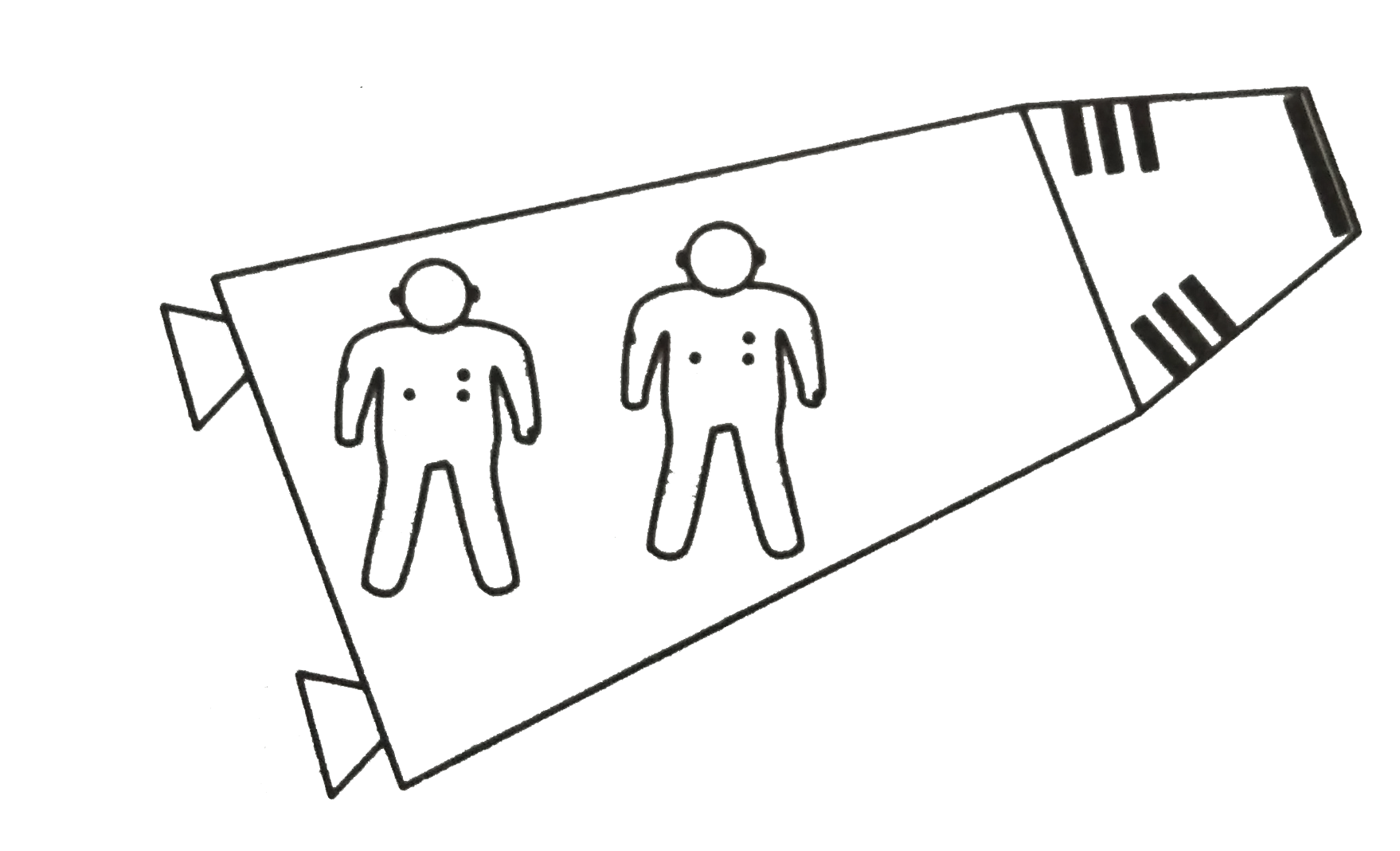Three particles of masses 20g, 30g and 40g are initially moving along the positive direction of the three coordinate axes respectively with the same velocity of 20cm/s. When due to their mutual interaction, the first particle comes to rest, the second acquires a velocity (10ˆi+20ˆk)cm/s. What is then the velocity of the third particle?
The correct Answer is:A, B, C
To solve the problem, we will use the principle of conservation of momentum. Here are the steps to find the velocity of the third particle:
Step 1: Identify the masses and initial velocities of the particles
- Mass of particle 1, m1=20g
- Mass of particle 2, m2=30g
- Mass of particle 3, m3=40g
The initial velocities for each particle are:
- →u1=20^icm/s (along x-axis)
- →u2=20^jcm/s (along y-axis)
- →u3=20^kcm/s (along z-axis)
Step 2: Write down the final velocities after interaction
- After the interaction:
- The first particle comes to rest: →v1=0
- The second particle acquires a new velocity: →v2=10^i+20^kcm/s
- The third particle's velocity is unknown: →v3
Step 3: Apply the conservation of momentum
According to the conservation of momentum:
Initial momentum=Final momentum
The initial momentum →Pi is given by:
→Pi=m1→u1+m2→u2+m3→u3
Substituting the values:
→Pi=20^i⋅20+30^j⋅20+40^k⋅20
Calculating each term:
→Pi=400^i+600^j+800^k
The final momentum →Pf is given by:
→Pf=m1→v1+m2→v2+m3→v3
Substituting the known values:
→Pf=20⋅0+30(10^i+20^k)+40→v3
Calculating:
→Pf=0+300^i+600^k+40→v3
Step 4: Set initial momentum equal to final momentum
Setting →Pi=→Pf:
400^i+600^j+800^k=300^i+600^k+40→v3
Step 5: Solve for →v3
Rearranging gives:
400^i+600^j+800^k=300^i+600^k+40→v3
This can be separated into components:
1. For ^i:
400=300+40v3x⟹100=40v3x⟹v3x=10040=2.5cm/s
2. For ^j:
600=0+0+40v3y⟹600=40v3y⟹v3y=60040=15cm/s
3. For ^k:
800=0+600+40v3z⟹200=40v3z⟹v3z=20040=5cm/s
Final Step: Combine the components to find →v3
Thus, the velocity of the third particle is:
→v3=2.5^i+15^j+5^kcm/s
Conclusion
The velocity of the third particle is:
→v3=2.5^i+15^j+5^kcm/s
- Mass of particle 1, m1=20g
- Mass of particle 2, m2=30g
- Mass of particle 3, m3=40g
- →u1=20^icm/s (along x-axis)
- →u2=20^jcm/s (along y-axis)
- →u3=20^kcm/s (along z-axis)
- After the interaction:
- The first particle comes to rest: →v1=0
- The second particle acquires a new velocity: →v2=10^i+20^kcm/s
- The third particle's velocity is unknown: →v3
According to the conservation of momentum:
Initial momentum=Final momentum
→Pi=m1→u1+m2→u2+m3→u3
Substituting the values:
→Pi=20^i⋅20+30^j⋅20+40^k⋅20
Calculating each term:
→Pi=400^i+600^j+800^k
→Pf=m1→v1+m2→v2+m3→v3
Substituting the known values:
→Pf=20⋅0+30(10^i+20^k)+40→v3
Calculating:
→Pf=0+300^i+600^k+40→v3
Setting →Pi=→Pf:
400^i+600^j+800^k=300^i+600^k+40→v3
Rearranging gives:
400^i+600^j+800^k=300^i+600^k+40→v3
This can be separated into components:
1. For ^i:
400=300+40v3x⟹100=40v3x⟹v3x=10040=2.5cm/s
2. For ^j:
600=0+0+40v3y⟹600=40v3y⟹v3y=60040=15cm/s
3. For ^k:
800=0+600+40v3z⟹200=40v3z⟹v3z=20040=5cm/s
Thus, the velocity of the third particle is:
→v3=2.5^i+15^j+5^kcm/s
The velocity of the third particle is:
→v3=2.5^i+15^j+5^kcm/s
Topper's Solved these Questions
- CENTRE OF MASS, LINEAR MOMENTUM AND COLLISIONBOOK - DC PANDEY ENGLISHCHAPTER - CENTRE OF MASS, LINEAR MOMENTUM AND COLLISIONEXERCISE - Exercise 11.4
4 Videos
- CENTRE OF MASS, LINEAR MOMENTUM AND COLLISIONBOOK - DC PANDEY ENGLISHCHAPTER - CENTRE OF MASS, LINEAR MOMENTUM AND COLLISIONEXERCISE - Exercise 11.5
4 Videos
- CENTRE OF MASS, LINEAR MOMENTUM AND COLLISIONBOOK - DC PANDEY ENGLISHCHAPTER - CENTRE OF MASS, LINEAR MOMENTUM AND COLLISIONEXERCISE - Exercise 11.2
6 Videos
- CENTRE OF MASS, IMPULSE AND MOMENTUMBOOK - DC PANDEY ENGLISHCHAPTER - CENTRE OF MASS, IMPULSE AND MOMENTUMEXERCISE - Comprehension type questions
15 Videos
- CIRCULAR MOTIONBOOK - DC PANDEY ENGLISHCHAPTER - CIRCULAR MOTIONEXERCISE - Medical entrances s gallery
19 Videos
Similar Questions
Three interacting particles of masses 100g,200g and 400g each hace a velocity of 20m/s magnitude along the positive direction of x-axis, y-axis and z-axis. Due to force of interaction the third particle stops moving. The velocity of the second particle is (10ˆj+5ˆk). What is the velocity of the first particle ?
View SolutionA particle is moving along a circle of radius 20cm, with a linear velocity of 2m//s. Calculate the angular velocity of the particle.
View SolutionA particle is moving along a circle of radius 20cm, with a linear velocity of 2m//s. Calculate the angular velocity of the particle.
View SolutionA particle moves with a uniform velocity of 50 m/s for 20 min. What is the velocity of particle at t = 2 min ?
View SolutionThe velocities of three particles of masses 20 g, 30 g and 50 g are 10ˆi, 10ˆj and 10ˆk respectively. The velocity of the centre of mass of the three particles is
View SolutionA particle moves in a straight line for 20 seconds with velocity 3 m/s and then moves with velocity 4 m/s for another 20 seconds and finally moves with velocity 5 m/s for next 20 seconds. What is the average velocity of the particle ?
View SolutionA particle of mass 20g experiences a gravitational force of 4.0N along positive x - direction. Find the gravitational field at that point.
View SolutionTwo objects of masses 100g and 200g are moving along the same line in the same direction with velocities of 2m/s and 1m/s, respectively. They collide and after the collison, the first object moves at a velocity of 1.67m/s in the same direction. Determine the velocity of the second object.
View SolutionTwo balls of equal masses are thrown upwards, along the same vertical direction at an interval of 2 seconds, with the same initial velocity of 40m/s. Then these collide at a height of (Take g=10m/s2).
View SolutionA block at rest explodes into three equal parts. Two parts start moving along X and Y axes respectively with equal speeds of 10 m/s. Find the initial velocity of the third part.

View Solution
